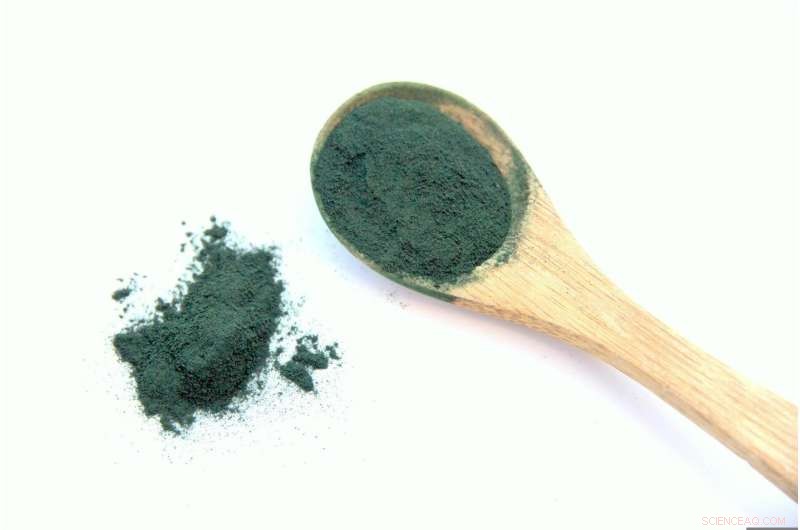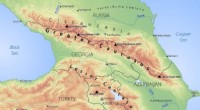Mikroalger lover rigelig sund mad og foder i ethvert miljø

Spirulina, en blågrøn mikroalge, er en fremragende kilde til mikronæringsstoffer og protein. Kredit:Anaïs CROUZET via Pixabay
Den globale fødevareforsyning står over for en række trusler, herunder klimaændringer, krige, skadedyr og sygdomme. En organisme, der er for lille til at det menneskelige øje kan se - mikroalger - kunne give nogle svar.
At brødføde en voksende verdensbefolkning, der ifølge FN's prognoser vil nå op på 9,8 milliarder i 2050, og behovet for at bevare naturressourcerne i de kommende generationer kan umiddelbart virke modstridende.
Men en løsning, selv om den endnu ikke er i sigte, er bestemt ikke uden for rækkevidde. Europæiske videnskabsmænd har for nylig udviklet en appetit på mikroalger, også kaldet fytoplankton, en undergruppe af alger bestående af encellede fotosyntetiske mikroorganismer.
De fleste kender til den største form for alger, tang eller tang. Den kan blive op til tre meter lang og er i nogle former en velkendt delikatesse. De beslægtede arter mikroalger, som kan findes i både havvand og ferskvand, har fået opmærksomhed i forskningen på grund af deres ekstraordinære egenskaber.
Disse mikroskopiske organismer kan bruges til dyrefoder, især i akvakultur, og forskellige fødevarer, herunder pasta, veganske pølser, energibarer, bageriprodukter og vegetabilske cremer.
De fleste kommercielle mikroalgedyrkning er centreret om produktion af tørret biomasse såsom chlorella eller spirulina-pulver som en fødevare, der giver betydelige sundhedsmæssige fordele. Nogle mikroalgestammer akkumulerer ikke kun op til 65-70 % protein, men er også bæredygtige kilder til omega-3-fedtsyrer - et stof, der konventionelt hovedsageligt stammer fra fisk og fiskeolie.
Yderligere bioaktive forbindelser, såsom vitamin B12, K eller D, betyder, at mikroalger indeholder betydelige sundhedsegenskaber, hvilket potentielt reducerer risikoen for kræft og hjerte-kar-sygdomme.
Ørkenalger
"Mikroalger kan dyrkes mange forskellige steder, under meget forskellige forhold," sagde Massimo Castellari, som er involveret i det Horizon-finansierede ProFuture-projekt, der har til formål at opskalere mikroalgeproduktionen. "Vi kan dyrke det på Island og i et ørkenklima."
Teknologierne til intensiv dyrkning af mikroalger har været under udvikling siden 1950'erne.
I dag dyrkes mikroalger i fotobioreaktorer med åbent eller lukket system, som er kar designet til at kontrollere biomasseproduktionen. Selv om den lukkede systemversion er dyrere at bygge, tilbyder den mere kontrol over eksperimentelle parametre og mindre risiko for kontaminering.
Stoffet er på ingen måde bare et trendy kosttilskud. For eksempel i Tchad, et indlandsstat lavindkomstland, har forbruget af spirulina høstet fra Tchad-søen markant forbedret folks ernæringsstatus, fordi spirulina er en fremragende kilde til proteiner og mikronæringsstoffer.
Ud over dens ernæringsmæssige værdi tilbyder mikroalger klimafordele ved at binde kuldioxid samt økonomiske fordele ved at bruge landbrugsområder mere effektivt og – gennem brugen af ikke-agerjord – udvide muligheden for biomasseproduktion.
With a total of less than 57,000 tons cultivated in 2019, according to the UN Food and Agriculture Organization (FAO), production of microalgae is still very much in its early stages. By comparison, primary-crop output was 9.4 billion tons in 2019.
Food inflation
Russia's continuing war in Ukraine has highlighted just how vulnerable global food supply can be. Halts to Ukrainian grain exports and increases in energy prices have helped push food inflation around the world to record highs, with developing countries being hit disproportionately hard. In May this year, costs for food had risen by 42% compared with 2014–2016, the UN reported.
Last year, as many as 828 million people were affected by hunger—an increase of roughly 46 million compared with 2020 and a surge of 150 million since the outbreak of the COVID-19 pandemic.
The FAO projects that some 670 million people will still face hunger by the end of the decade.
While the benefits of cultivating organic microalgae for food and feed are substantial, market growth will require overcoming obstacles including a lack of automated production in the industry, according to Castellari, who works at the Institute of Agrifood Research and Technology in Barcelona, Spain.
"The automatization is still not completely implemented," he said. "There are small producers in Europe—many steps still involve manual labor. So they are still working on optimizing the process."
Processed biomass
The challenges go well beyond cultivation. With microalgae, biomass has to be processed, cleaned and dried before a usable powder can be obtained. The next step is to scale up production to drive down costs.
In addition, there are regulatory challenges. Only a few species of microalgae are currently authorized in the European Union.
"In Europe it's still in a preliminary stage of development," said Castellari. "There are thousands of species of microalgae, but for food consumption or feed there are only seven species authorized."
To gain knowledge about the possibilities to use other species, Castellari and his team are also investigating these other kinds of microalgae.
Due to these challenges, the portfolio of products containing microalgae remains limited today. But, if these hurdles can be overcome, the overall prospects for the microalgae industry are promising. Besides being a source of food and feed, the plant can be used for biofuels, cosmetics, fertilizer and health supplements.
Astaxanthin, a blood-red pigment extracted from algae, already has notable uses. A powerful antioxidant, astaxanthin can be found in seafood and is commonly used to color shrimp. It is also sold in the form of pills as a food supplement.
Astaxanthin is thought to have potentially a positive impact on brain function, athletic performance and aging skin, among other things.
Matteo Ballottari, associate professor of biotechnology at the University of Verona in Italy, helped start the European Research Council's Horizon-funded project AstaOmega simultaneously to produce astaxanthin and omega-3 fatty acids in microalgae for aquaculture and human nutrition.
Quality and quantity
Most omega-3 supplements are derived from fish oils. This, however, raises sustainability concerns such as damage to marine ecosystems as a result of overfishing.
"There is more demand for eating high-quality foods, along with an awareness for incorporating omega-3 rich ingredients in our diets," Ballottari said. Responding to this trend while feeding a growing world population is 'a big challenge," he said.
Meanwhile, on the astaxanthin front, the AstaOmega researchers have made progress. They have been able to obtain a new strain that can produce astaxanthin on its own, without needing to be "stressed." This means the researchers don't have to change production parameters such as light intensity, temperature or nitrates concentration. Also, extracting the substance has become easier, resulting in lower costs.
Scientists agree that microalgae have the potential to change the ways in which we eat for the better.
"Microalgae can help us to increase the protein production within Europe to reduce our dependence on other countries," said Castellari of the ProFuture project. + Udforsk yderligere
Large-scale cultivation of microalgae can clean emissions from industry, can also be used in Nordic climate
 Varme artikler
Varme artikler
-
 Ny screeningsteknik vil give afgrødeavlere mulighed for hurtigere at udvikle tørkebestandige sorte…Scanning af elektronmikrografer af den epikutikulære ultrastruktur af flagblade, der er indsamlet fra planter, der var kommet helt frem. Billeder blev taget fra adaxial og abaxial overflade af Stettle
Ny screeningsteknik vil give afgrødeavlere mulighed for hurtigere at udvikle tørkebestandige sorte…Scanning af elektronmikrografer af den epikutikulære ultrastruktur af flagblade, der er indsamlet fra planter, der var kommet helt frem. Billeder blev taget fra adaxial og abaxial overflade af Stettle -
 Hvad betyder kaukasisk egentlig?Større Kaukasus -regionen er, hvor kaukasiere - ægte kaukasiere - kalder hjem. Folk fra Georgien, Rusland, Aserbajdsjan og Armenien hagler fra området. FreeWorldMaps.net En gang imellem, på en af d
Hvad betyder kaukasisk egentlig?Større Kaukasus -regionen er, hvor kaukasiere - ægte kaukasiere - kalder hjem. Folk fra Georgien, Rusland, Aserbajdsjan og Armenien hagler fra området. FreeWorldMaps.net En gang imellem, på en af d -
 Nysgerrig hvidhaj leger med kameraetStor hvid haj inspicerende videosæt. Kredit:Massey University Massey-forskere fangede nogle forbløffende optagelser af en stor hvidhaj på en nylig forskningsekspedition til det sydvestlige Stilleh
Nysgerrig hvidhaj leger med kameraetStor hvid haj inspicerende videosæt. Kredit:Massey University Massey-forskere fangede nogle forbløffende optagelser af en stor hvidhaj på en nylig forskningsekspedition til det sydvestlige Stilleh -
 Menneskelige rester fundet i stor australsk krokodilleSaltvandskrokodiller, som kan blive op til syv meter lang og veje mere end et ton, er et fællestræk i Australiens tropiske nord og dræber i gennemsnit to mennesker om året Menneskelige rester blev
Menneskelige rester fundet i stor australsk krokodilleSaltvandskrokodiller, som kan blive op til syv meter lang og veje mere end et ton, er et fællestræk i Australiens tropiske nord og dræber i gennemsnit to mennesker om året Menneskelige rester blev
- Billede:Hubble genbesøger slørtågen
- Kvanteffekter observeret ved fotosyntese
- Seks klimaforandringsløsninger kan vi alle blive enige om
- Vandfremtiden for Jordens tredje pol
- Planters reaktion på tørke kan ses i atmosfærens sammensætning
- Universel ret til sundhed kunne inspirere mennesker, organisationer til at skabe reel forandring


